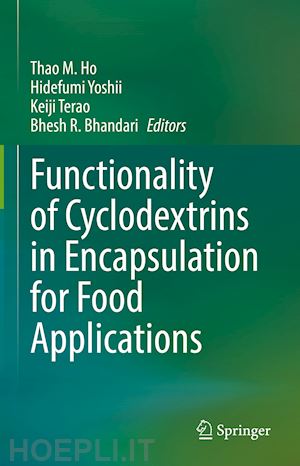
Questo prodotto usufruisce delle SPEDIZIONI GRATIS
selezionando l'opzione Corriere Veloce in fase di ordine.
Pagabile anche con Carta della cultura giovani e del merito, 18App Bonus Cultura e Carta del Docente
Cyclodextrins (CD) are cyclic oligosaccharides containing 6, 7 or 8 glucose units (a, ß or ?-CD, respectively) in a truncated molecular shape. Their cyclic molecular structure contains a hydrophilic surface and a hydrophobic cavity at the center that can interact (host) with external hydrophobic compounds (guest molecules). Cyclodextrins have been categorized as Generally Recognized As Safe (GRAS) in the USA, “natural products” in Japan, and as “novel food” in Australia, New Zealand and EU countries. They are therefore widely used in food production to encapsulate hydrophobic compounds, including solid, liquid and gas molecules, in order to solubilize, stabilize or control the release rate of these components. To date, there has been no comprehensive review of the very large number of studies performed on encapsulation using cyclodextrin powders for food applications in recent years.
This text fills that gap for academics in the encapsulation field and for industry professionals who want to gain a solid understanding of encapsulation functionality of cyclodextrin powders. The book consists of 16 chapters in which chapter 1 introduces cyclodextrin properties and its applications in food processing, and chapters 2-16 explore applications of cyclodextrin in encapsulation for many guest compounds. These compounds include gases, flavors, colors, pigments, polyphenols (plant bioactive compounds), essential oils, lipids (cholesterol and polyunsaturated fatty acids), vitamins, fruit ripening controlling compounds, and antifungal and antimicrobial compounds. These chapters also discuss functionalities of cyclodextrin in packaging, masking off-flavor and off-taste, and as dietary fiber.
Covering a broad range of cyclodextrin applications and suitable for both newcomers to encapsulation technology and those with experience, Functionality of Cyclodextrins in Encapsulation for Food Applications is a unique and essential reference on this increasingly important topic.
Chapter 1: Properties of cyclodextrins and their applications in food processing.- Chapter 2: Solid encapsulation method: ethylene gas encapsulation into amorphous alpha-cyclodextrin powder.- Chapter 3: Encapsulation of gases.- Chapter 4: Encapsulation of flavours.- Chapter 5: Encapsulation of colour and pigments.- Chapter 6: Encapsulation of polyphenols (plant bioactive compounds).- Chapter 7: Encapsulation of essential oils.- Chapter 8: Encapsulation of lipids.- Chapter 9: Encapsulation of nutraceuticals, vitamins.- Chapter 10: Encapsulation of antimicrobial compounds.- Chapter 11: Encapsulation for packaging.- Chapter 12: Encapsulation for masking off-flavour and off-tasting in food production.- Chapter 13: Alpha-cyclodextrin functions as a dietary fiber.- Chapter 14: Complexation of ingredients in foods by alpha-cyclodextrin to improve their functions.- Chapter 15: Fruits package with 1-methylcylopropene included alpha-cyclodextrin.- Chapter 16: Encapsulation of fruit ripening controlling compounds.
Thao M. Ho is a Postdoctoral Researcher in the Department of Food and Nutrition at the University of Helsinki in Helsinki, Finland and an Honorary Fellow in the School of Agriculture and Food Sciences at the University of Queensland in Brisbane, Australia.
Hidefumi Yoshii is a Professor of Food Engineering Lab in the Department of Food Science and Human Nutrition at Setsunan University in Osaka, Japan and the Emeritus Professor of Kagawa University in Takamatsu, Japan.
Keiji Terao is the President of CycloChem Bio Co., Ltd. in Kobe, Japan and a Guest Professor in the Graduate School of Medicine at Kobe University in Kobe, Japan.
Bhesh R. Bhandari is a Professor of Food Engineering in the School of Agriculture and Food Sciences at the University of Queensland in Brisbane, Australia.











Il sito utilizza cookie ed altri strumenti di tracciamento che raccolgono informazioni dal dispositivo dell’utente. Oltre ai cookie tecnici ed analitici aggregati, strettamente necessari per il funzionamento di questo sito web, previo consenso dell’utente possono essere installati cookie di profilazione e marketing e cookie dei social media. Cliccando su “Accetto tutti i cookie” saranno attivate tutte le categorie di cookie. Per accettare solo deterninate categorie di cookie, cliccare invece su “Impostazioni cookie”. Chiudendo il banner o continuando a navigare saranno installati solo cookie tecnici. Per maggiori dettagli, consultare la Cookie Policy.